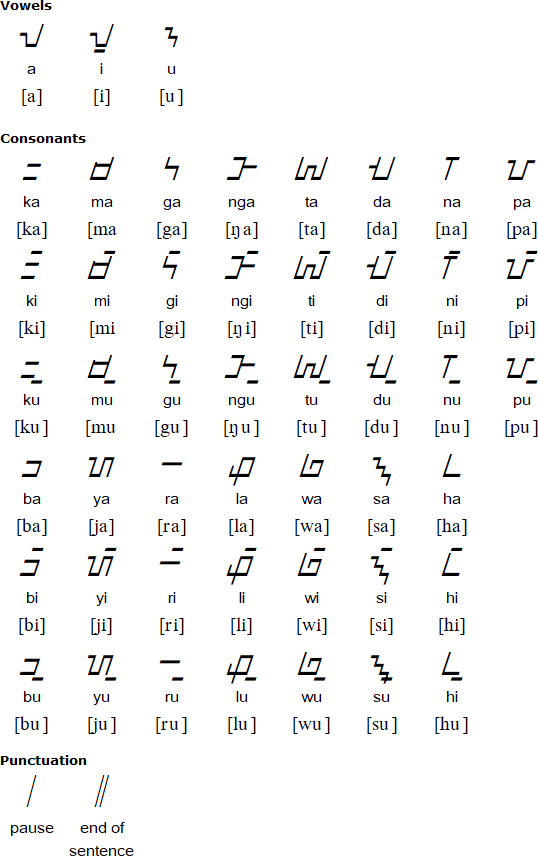Buhid is a Philippine language spoken by the Mangyan people on the island of Mindoro in the Philippines, mainly in Mindoro Occidental and Mindoro Oriental provinces. In 2009 there were about 9,300 Buhid speakers. Buhid is also known as Mangyan, Bangon, Batangan or Bukil.
The Buhid or Mangyan alphabet is thought to have descended from the Kawi script of Java, Bali and Sumatra, which in turn descended from the Pallava script, one of the southern Indian scripts derived from Brahmi.
The Buhid alphabet is still used in the Philipines by the Buhid people of Mindoro. Buhid is also written with the Latin alphabet.

Download an alphabet chart for Buhid (Excel)

Information about the Buhid language and alphabet
https://en.wikipedia.org/wiki/Buhid_language
https://www.ethnologue.com/language/bku
http://glottolog.org/resource/languoid/id/buhi1245
https://archive.org/details/rosettaproject_bku_phon-1
Aborlan Tagbanwa, Agutaynen, Bantik, Bikol, Binukid, Blaan, Buhid, Bukid, Buol, Calmian Tagbanwa, Casiguran Dumagat Agta, Central Tagbanwa, Gorontalo, Hanuno'o, Iranun, Iraya, Isnag, Kagayanen, Kalanguya, Kapampangan, Klata, Maguindanao, Mamanwa, Manide, Maranao, Matigsalug, Molbog, Mongondow, Obo, Palawano, Ponosakan, Ratahan, Rinconada Bikol, Sangirese, Suwawa, Tagalog, Tagabawà, Talaud, Tawbuid, Tboli, Tiruray, Tombulu, Tondano, Tonsawang, Umiray Dumaget, Western Subanon
Languages written with the Latin alphabet
Ahom, Aima, Arleng, Badagu, Badlit, Basahan, Balinese, Balti-A, Balti-B, Batak, Baybayin, Bengali, Bhaiksuki, Bhujimol, Bilang-bilang, Bima, Blackfoot, Brahmi, Buhid, Burmese, Carrier, Chakma, Cham, Cree, Dehong Dai, Devanagari, Dham Lipi, Dhankari / Sirmauri, Ditema, Dives Akuru, Dogra, Ethiopic, Evēla Akuru, Fox, Fraser, Gond, Goykanadi, Grantha, Gujarati, Gunjala Gondi, Gupta, Gurmukhi, Halbi Lipi, Hanifi, Hanuno'o, Hočąk, Ibalnan, Incung, Inuktitut, Jaunsari Takri, Javanese, Kaithi, Kadamba, Kamarupi, Kannada, Kawi, Kharosthi, Khema, Khe Prih, Khmer, Khojki, Khudabadi, Kirat Rai, Kōchi, Kodava Lipi, Komering, Kulitan, Kurukh Banna, Lampung, Lanna, Lao, Lepcha, Limbu, Lontara/Makasar, Lota Ende, Magar Akkha, Mahajani, Malayalam, Meitei (Modern), Manpuri (Old), Marchen, Meetei Yelhou Mayek, Meroïtic, Masarm Gondi, Modi, Mon, Mongolian Horizontal Square Script, Multani, Nandinagari, Newa, New Tai Lue, Ojibwe, Odia, Ogan, Pahawh Hmong, Pallava, Phags-pa, Purva Licchavi, Qiang / Rma, Ranjana, Rejang (Kaganga), Sasak, Savara, Satera Jontal, Shan, Sharda, Sheek Bakrii Saphaloo, Siddham, Sinhala, Sorang Sompeng, Sourashtra, Soyombo, Sukhothai, Sundanese, Syloti Nagri, Tagbanwa, Tai Noi, Takri, Tamil, Tanchangya (Ka-Pat), Tani, Thaana, Telugu, Thai, Tibetan, Tigalari, Tikamuli, Tocharian, Tolong Siki, Vatteluttu, Warang Citi
Page last modified: 13.04.23
[top]
You can support this site by Buying Me A Coffee, and if you like what you see on this page, you can use the buttons below to share it with people you know.

If you like this site and find it useful, you can support it by making a donation via PayPal or Patreon, or by contributing in other ways. Omniglot is how I make my living.
Note: all links on this site to Amazon.com, Amazon.co.uk
and Amazon.fr
are affiliate links. This means I earn a commission if you click on any of them and buy something. So by clicking on these links you can help to support this site.
[top]